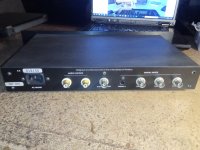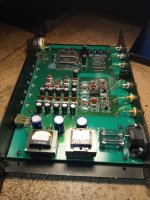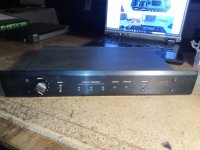We got us wrong. I thought about tonal differences you can not see in these data. Of course you (and I) can measure CD player, but we can often not measure why two player with identical measurements sound different. Like " because of 0.95dB at 20kHz this player reproduces picking of steel guitars much more realistic". This is guessing, not measuring.
By the way, I do not care about .001 THD or 107 to 111 dB SNR. I care for audible improvements. The hardest thing is to say what is better and what is only different. Something really wrong, that is gone after a modification, falls into the "better" department. Like something that is audible and was not audible before.
Just a little more bass or rolled back tremble are not better or worse. They may be just artificially generated to sound different. Larger cap here, smaller resistor there, done.
For the majority of "audiophiles" under compareable quality speakers, the louder ones are the winner in any test. That just for an example.
Normal consumers are even worse, they don't even know what to listen to. Usually they wait for something spectacular, like a high head percing their ear drum or some bass they feel under their feet. Then you see them smile...
They talk about "sound" and in reality want some effect, not a natural reproduction.
I have done enough high end installation over the years and know my gold ears.
Today I'm just surprised how low the audible difference between low priced, selected gear and over priced "high end" stuff is. You can spend 50.000$ more and get a worse or identical audio reproduction if you choose the right, overpriced parts. Think of power amps, wires, DAC's, streaming gear and all that "conditioning" snake oil filled stuff.
By the way, I do not care about .001 THD or 107 to 111 dB SNR. I care for audible improvements. The hardest thing is to say what is better and what is only different. Something really wrong, that is gone after a modification, falls into the "better" department. Like something that is audible and was not audible before.
Just a little more bass or rolled back tremble are not better or worse. They may be just artificially generated to sound different. Larger cap here, smaller resistor there, done.
For the majority of "audiophiles" under compareable quality speakers, the louder ones are the winner in any test. That just for an example.
Normal consumers are even worse, they don't even know what to listen to. Usually they wait for something spectacular, like a high head percing their ear drum or some bass they feel under their feet. Then you see them smile...
They talk about "sound" and in reality want some effect, not a natural reproduction.
I have done enough high end installation over the years and know my gold ears.
Today I'm just surprised how low the audible difference between low priced, selected gear and over priced "high end" stuff is. You can spend 50.000$ more and get a worse or identical audio reproduction if you choose the right, overpriced parts. Think of power amps, wires, DAC's, streaming gear and all that "conditioning" snake oil filled stuff.
Last edited:
This is what I use if your transport sounds "soo much better" and I want to verify. Not the best DAC in the world, but straight build and 3 identical inputs. All you need is two copies of your reference CD and A-B is only the turn of a knob.
Attachments
Sorry, I pass here. If I were interested in comparing transports then I would most probably go listening to streaming services. I just like the old time players as such until they last 😉This is what I use if your transport sounds "soo much better" and I want to verify.
I agree to that. But tonal differences caused by dried out lytics in the RCA output path and different opamps that get used can usually be audible and sometimes measurable.I thought about tonal differences you can not see in these data.
Last year I bought - out of plain curiocity - Marantz CD6000OSE where opamps have been replaced by HDAM modules (no opamps, just HDAM stages). I have not yet had time to take out the main board for replacing or bypassing its initial stage of output capacitors and muting transistors. For quick A-B comparison I think that a cheap relay based output selector can become handy.
It is hard to except, but the times I lived in are gone. I feel it more and more each day. CD's are obsolete. like values one used to think would be immortal.
Just as hard as to live in a world where right and wrong are only a thing of oppinion. And the bully shouting the loudest lies is right...
Just as hard as to live in a world where right and wrong are only a thing of oppinion. And the bully shouting the loudest lies is right...
Agree to that, but I have no intention yet to start digging my own grave. So why not have fun until we can 😉It is hard to except, but the times I lived in are gone.
Age with capacitors was allways a problem. We knew it 1970 when I started with electronics and they tried to avoid them on high quality gear.
Testing a powersupply under load has never been a problem. Gotten easyer with symetric voltages, as you see coarse differences in a second, on the most basic scope.
Testing a powersupply under load has never been a problem. Gotten easyer with symetric voltages, as you see coarse differences in a second, on the most basic scope.
- Home
- Source & Line
- Digital Source
- Marantz CD67SE enlightenment appreciated


